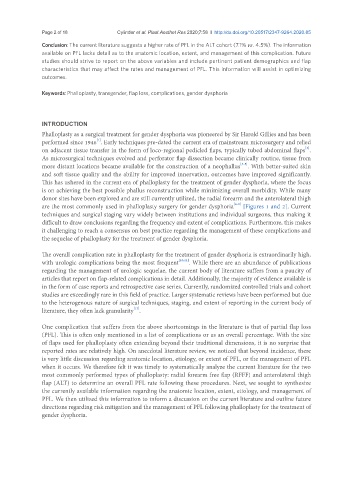Page 668 - Read Online
P. 668
Page 2 of 18 Cylinder et al. Plast Aesthet Res 2020;7:58 I http://dx.doi.org/10.20517/2347-9264.2020.85
Conclusion: The current literature suggests a higher rate of PFL in the ALT cohort (7.1% vs. 4.5%). The information
available on PFL lacks detail as to the anatomic location, extent, and management of this complication. Future
studies should strive to report on the above variables and include pertinent patient demographics and flap
characteristics that may affect the rates and management of PFL. This information will assist in optimizing
outcomes.
Keywords: Phalloplasty, transgender, flap loss, complications, gender dysphoria
INTRODUCTION
Phalloplasty as a surgical treatment for gender dysphoria was pioneered by Sir Harold Gillies and has been
[1]
performed since 1946 . Early techniques pre-dated the current era of mainstream microsurgery and relied
[2]
on adjacent tissue transfer in the form of loco-regional pedicled flaps, typically tubed abdominal flaps .
As microsurgical techniques evolved and perforator flap dissection became clinically routine, tissue from
[3-5]
more distant locations became available for the construction of a neophallus . With better-suited skin
and soft tissue quality and the ability for improved innervation, outcomes have improved significantly.
This has ushered in the current era of phalloplasty for the treatment of gender dysphoria, where the focus
is on achieving the best possible phallus reconstruction while minimizing overall morbidity. While many
donor sites have been explored and are still currently utilized, the radial forearm and the anterolateral thigh
[6-9]
are the most commonly used in phalloplasty surgery for gender dysphoria [Figures 1 and 2]. Current
techniques and surgical staging vary widely between institutions and individual surgeons, thus making it
difficult to draw conclusions regarding the frequency and extent of complications. Furthermore, this makes
it challenging to reach a consensus on best practice regarding the management of these complications and
the sequelae of phalloplasty for the treatment of gender dysphoria.
The overall complication rate in phalloplasty for the treatment of gender dysphoria is extraordinarily high,
with urologic complications being the most frequent [10,11] . While there are an abundance of publications
regarding the management of urologic sequelae, the current body of literature suffers from a paucity of
articles that report on flap-related complications in detail. Additionally, the majority of evidence available is
in the form of case reports and retrospective case series. Currently, randomized controlled trials and cohort
studies are exceedingly rare in this field of practice. Larger systematic reviews have been performed but due
to the heterogenous nature of surgical techniques, staging, and extent of reporting in the current body of
[12]
literature, they often lack granularity .
One complication that suffers from the above shortcomings in the literature is that of partial flap loss
(PFL). This is often only mentioned in a list of complications or as an overall percentage. With the size
of flaps used for phalloplasty often extending beyond their traditional dimensions, it is no surprise that
reported rates are relatively high. On anecdotal literature review, we noticed that beyond incidence, there
is very little discussion regarding anatomic location, etiology, or extent of PFL, or the management of PFL
when it occurs. We therefore felt it was timely to systematically analyze the current literature for the two
most commonly performed types of phalloplasty: radial forearm free flap (RFFF) and anterolateral thigh
flap (ALT) to determine an overall PFL rate following these procedures. Next, we sought to synthesize
the currently available information regarding the anatomic location, extent, etiology, and management of
PFL. We then utilized this information to inform a discussion on the current literature and outline future
directions regarding risk mitigation and the management of PFL following phalloplasty for the treatment of
gender dysphoria.

